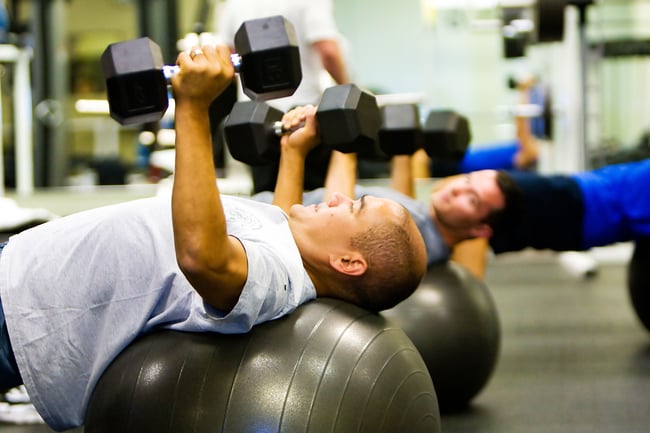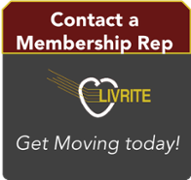Dumbbell Lunges
Step 1: Grab a dumbbell in each hand and hold them at side of body with arms straight.
Step 2: Step forward until front leg thigh is parallel with the ground and back leg knee is 1-2 inches from the ground.
Step 3: Step back to return to starting position and repeat movement with other leg to complete the repetition.
Step 4: Find a place where you can lunge down and back. If this is your first time doing lunges, try lunging down half way and back. Then build yourself up to lunging down to a further point.
LOOKING FOR MORE GREAT Leg WORKOUTS?
Check out our leg workouts exercise library.
NEED HELP GETTING STARTED?
Our highly trained and certified staff would love to help you reach your goals. Click on the link below to request a trainer. Don't wait, start today!
Topics: Workouts
Box Jumps
If you're new to box jumps, start off nice and easy, practicing stepping onto the box at first and then moving up to jumping. At the beginning, choose a low box that's under 12 inches high. You could even stack a few plates and jump on those as you progress. As you become more comfortable, you can build up to an 18-inch box, a 20-inch box, and maybe even a 24-inch box, depending on your jumping abilities and how tall you are.
Step 1: Stand with your feet slightly wider than hips-width distance apart in front of a sturdy box.
Step 2: Bend your knees and swing your arms back.
Step 3: Jump onto the top of the box with both feet at the same time, swinging the arms forward to give you a little momentum.
Step 4: Once you land, stand up until your legs are straight and drive your hips forward.
Step 5: Step one foot at a time back to the floor or jump down softly with both feet.
Step 6: This counts as one rep.
Step 7: Complete three sets of 10 to 20 box jumps.
LOOKING FOR MORE GREAT Aerobic WORKOUTS?
Check out our aerobic workouts exercise library.
NEED HELP GETTING STARTED?
Our highly trained and certified staff would love to help you reach your goals. Click on the link below to request a trainer. Don't wait, start today!
Topics: Workouts
Hanging Knee Raises
The hanging knee raise is a core strengthening exercise that targets the lower abdominals, hip flexors, and lower back. This exercise will also increase stability in the upper back and shoulders.
Step 1: Dead hang from a pull-up bar or Roman chair with a grip that's comfortable, with your arms and legs fully extended, and feet off the ground.
Step 2:Raise your knees up into one side, going about 90 degrees at the hip. Avoid any swinging, performing the exercise with control.
Step 3: Return to the starting position and then perform the movement to the other side. Continue alternating until the set in complete.
Step 4: Repeat as many times as you can.
Looking for more great ab workouts?
Check out our ab workouts exercise library.
Need help getting started?
Our highly trained and certified staff would love to help you reach your goals. Click on the link below to request a trainer. Don't wait, start today!
Topics: Workouts
Barbell Front Raises
The barbell front raise is a great exercise to tone your shoulders. Remember to not swing back your body in order to raise the weight. Lower the weight if you find yourself doing this. You can also stand with your back against a wall to maintain proper form. Stand tall with feet shoulder-width apart.
Step 1: Grab a barbell and stand up straight. The barbell should be in front of your thighs with your hands facing down. Hands should be shoulder-width apart. This is the starting position.
Step 2: While keeping your torso stationary, lift the barbell to the front. Your elbows should be slightly bent. Lift the barbell up until your arms are slightly above the level where they would be parallel to the floor. Exhale as you do so, and pause for a second when you get to the top.
Step 3: Lower the barbell back to the starting position, inhaling as you do so.
Step 4: Complete 3 to 4 sets of 12 to 15 repetitions.
Looking for more great shoulder workouts? Check out our shoulder workouts exercise library.
Need help getting started? Our highly trained and certified staff would love to help you reach your goals. Click on the link below to request a trainer. Don't wait, start today!
Topics: Workouts
Is Muscle Soreness After a workout An Indicator of A Good Workout?

People always tell me if they were sore after a personal training session or group class. Many post on social media about how sore they were after their workout. There are memes all over the Internet about not being able to walk after leg day. It is almost like a badge of honor for some, but is soreness an indicator of a good workout? Is a workout still effective if you aren’t sore the next day?
In short, yes, your workout is still effective even if you aren’t sore! When you first start a new workout, your muscles are not used to the challenge and you will probably feel it the next day or so. However, after a period of completing those exercises, your body adapts to the movements and you most likely don’t feel soreness. Muscle soreness is just telling you that you changed something, overdid it, or did something your body wasn’t used to. So how do you know if you are getting results if you aren’t sore? By measuring your progress in other ways such as a workout log, measurements, pictures or by how you feel. So how do you get that progression without being sore?
To improve your strength and overall fitness you must progress your routine. Doing the exact same thing over and over for months won’t result in improvement after a period of time. Your body will adapt to your movements and needs a change every few months to challenge your muscles. You can do this by altering your exercises, increasing your weight and/or changing the number of repetitions you do. Some slight soreness is expected after you first make these adjustments, however, excessive soreness may occur when you make too large of an increase. For example, if you have been using a 5 lb weight for bicep curls for weeks and then start using 15 lbs.. Or if you have never run over 2 miles at a time but go and run a half marathon (13.1 miles). Without slowly increasing your weight or your miles in these examples, you are going to be super sore and are risking injury. Gradually making adjustments to your fitness routine will challenge your body but will only result in possible minor soreness right after you make those changes. You can progress effectively without intense discomfort.
Some muscle soreness is normal after making a change to your routine. However, it shouldn’t be all of the time and doesn’t have to be extreme. Don’t use soreness as an indicator of a good workout. Measure your results by using a workout log, measurements, pictures or by how you feel. The key is to gradually and sensibly progress your workouts. This can be done by understanding your current levels of fitness and strength and applying small and frequent increases in intensities or volume according to where you are now. You can avoid muscle soreness and still achieve great results.
Topics: LivRite News, Workouts




